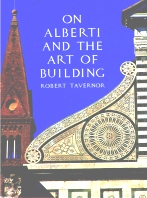
| Book Review |
|---|
Robert Tavernor. On Alberti and the Art of Building (New Haven: Yale University Press, 1998). To order this book, click here!
Reviewed by Kim Williams
 Few architects
offer as many points of departure for studies in architecture
and mathematics as Leon Battista Alberti. True Renaissance man,
both architect and mathematician, he left us a collection of
written works on architecture (De re aedificatoria), the
arts (De statue, De pictura) and mathematics (Ludi
rerum matematicarium), as well as a small but rich collection
of buildings to study. Yet perhaps because few of us can match
Alberti in either his range of skills or the broad scope of his
knowledge, studies tend to concentrate on one facet or another
of his work. A book such as this present volume, which presents
Alberti as both a theoretician and practitioner, is particularly
welcome.
Few architects
offer as many points of departure for studies in architecture
and mathematics as Leon Battista Alberti. True Renaissance man,
both architect and mathematician, he left us a collection of
written works on architecture (De re aedificatoria), the
arts (De statue, De pictura) and mathematics (Ludi
rerum matematicarium), as well as a small but rich collection
of buildings to study. Yet perhaps because few of us can match
Alberti in either his range of skills or the broad scope of his
knowledge, studies tend to concentrate on one facet or another
of his work. A book such as this present volume, which presents
Alberti as both a theoretician and practitioner, is particularly
welcome.
The book is organized to present a portrait of Alberti's ideas in the first chapters, and a study of the application of those ideas to actual building projects in the later chapters. It is remarkable how inseparable are the mathematical concepts from the artistic concepts. All of Alberti's basic tenets may be related to mathematical terms: concinnitas, related to concinnus, "pleasing, on account of harmony and proportion" (p. 43); numerus, number; finitio, measured outline; collocatio, composition, which includes attention to the correct proportioning of every element.
One aspect of Alberti's character is of particular interest to this reviewer, and undoubtedly influenced his theories: he was an inveterate measurer. He measured the human body, the architectural details of the ancients, the whole city of Rome; when he felt that existing instruments of measurement were lacking, he designed his own. This quest for precision and a desire to define ("his search for ‘the truth and certitude of reason'"–p. 13) are in turn reflected in his theories of proportion and harmony, and again in his built works. The facade of Santa Maria Novella, for instance, is an exercise in the tiling of the plane, a breaking down of total surface area into harmonious compartments. In doing this, he provides the spectator with a group of additive units, by which he may visually take the measure of the building. Tavernor covers this aspect of Alberti's activities well, with an entire chapter devoted to the survey of Rome undertake by Alberti in about 1444 and his subseguent hand in Roman urban affairs.
Robert Tavernor presents this book as a companion to the catalogue of the exhibit on Alberti that took place in Mantua in 1994, which provided something of a summary of current thinking on Alberti's work. The non-specialist will find the present volume more accessible than the exhibit catalogue, however, as it presents the valuable overview of Albert's work that the catalogue presumed the reader already possessed. The author's clear definitions of the ideas basic to Alberti's works, both theoretical and practical, are of great value to those who wish to organize their own pursuits of number, proportion and measure. The book is thoroughly, and in some cases beautifully, illustrated. Those who already possess the translation of Alberti's De re aedificatoria that Robert Tavernor co-authored will want to set this present volume next to it in their libraries.
RELATED SITES
ON THE WWW
Alberti:
Harmony and Proportion
Leon
Battista Alberti
Art
Dossier no. 93: Leon Battista Alberti
ABOUT
THE REVIEWER
Kim Williams is the director of the Nexus conferences
on architecture and mathematics and the editor of the Nexus Network
Journal.


Copyright ©2000 Kim Williams Books